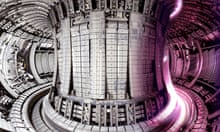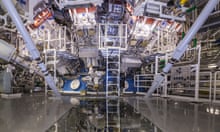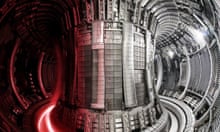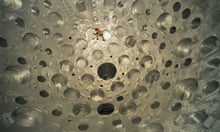Scientists have confirmed a major breakthrough has been made that could pave the way for abundant clean energy in the future after more than half a century of research into nuclear fusion.
Researchers at the US National Ignition Facility in California said fusion experiments had released more energy than was pumped in by the lab’s enormous, high-powered lasers, a landmark achievement known as ignition or energy gain.
The technology is far from ready to turn into viable power plants – and is not about to solve the climate crisis – but scientists hailed the breakthrough as evidence that the power of the stars can be harnessed on Earth.
Dr Arati Prabhakar, the policy director at the White House Office of Science and Technology, said: “Last week … they shot a bunch of lasers at a pellet of fuel and more energy was released from that fusion ignition than the energy of the lasers going in. This is such a tremendous example of what perseverance really can achieve.”
Fusion energy raises the prospect of plentiful clean power: the reactions release no greenhouse gases nor radioactive waste by-products. A single kilogram of fusion fuel, which is made up of heavy forms of hydrogen called deuterium and tritium, provides as much energy as 10m kilograms of fossil fuel. But it has taken 70 years to reach this point.
Speaking at the announcement on Tuesday, Jill Hruby, of the National Nuclear Security Administration (NNSA), said the US had “taken the first tentative step towards a clean energy source that could revolutionise the world”.
The National Ignition Facility is a vast complex at the Lawrence Livermore National Laboratory, near San Jose. It was built to perform experiments that recreate, briefly and in miniature, the processes unleashed inside nuclear bombs, enabling the US to maintain its nuclear warheads without the need for nuclear tests.
But the experiments are also stepping stones towards clean fusion power. To achieve the reactions, researchers fire up to 192 giant lasers into a centimetre-long gold cylinder called a hohlraum. The intense energy heats the container to more than 3m degrees celcius – hotter than the surface of the sun – and bathes a peppercorn-sized fuel pellet inside in X-rays.
The X-rays strip the surface off the pellet and trigger a rocket-like implosion, driving temperatures and pressures to extremes only seen inside stars, giant planets and nuclear detonations. The implosion reaches speeds of 400km per second and causes the deuterium and tritium to fuse.
Each fusing pair of hydrogen nuclei produces a lighter helium nucleus, and a burst of energy according to Einstein’s equation E=mc2. Deuterium is easily extracted from seawater, while tritium can be made from lithium which is found in the Earth’s crust.
In the latest experiment, researchers pumped in 2.05 megajoules of laser energy and got about 3.15MJ out – a roughly 50% gain and a sign that fusion reactions in the pellet were driving further fusion reactions. “The energy production took less time than it takes light to travel one inch,” said Dr Marvin Adams, at the NNSA.
Immense hurdles remain, however, in the quest for fusion power plants. While the pellet released more energy than the lasers put in, the calculation does not include the 300 or so megajoules needed to power up the lasers in the first place. The NIF lasers fire about once a day, but a power plant would need to heat targets 10 times per second. Then there is the cost of the targets. The ones used in the US experiment cost tens of thousands of dollars, but for a viable power plant, they would need to cost pence. Another issue is how to get the energy out as heat.
Dr Kim Budil, the director of the Lawrence Livermore National Laboratory, said with enough investment, a “few decades of research could put us in a position to build a power plant”. A power plant based on alternative technology used at the Joint European Torus (JET) in Oxfordshire could be ready sooner, she added.
“In some senses everything changes; in another, nothing changes,” said Justin Wark, a professor of physics at the University of Oxford and the director of the Oxford Centre for High Energy Density Science. “This result proves what most physicists always believed – fusion in the laboratory is possible. However, the obstacles to be overcome to make anything like a commercial reactor are huge, and must not be underestimated.”
He said that asking how long it could take to overcome the challenges was like asking the Wright brothers how long it would take to build a plane to cross the Atlantic just after their maiden flight. “I understand that everyone wants to think of this as being the great solution to the energy crisis. It is not, and whoever says it is with any certainty is misleading.
“It is highly unlikely that fusion will impact on a timescale sufficiently short to impact our current climate change crisis, so there must be no let up on our efforts in that regard.
“The latest results also show that the basic science works – the laws of physics do not prevent us from achieving the goal – the problems are technical and economic. As Niels Bohr, the Nobel prize-winning atomic physicist once said: ‘Prediction is very difficult, especially when it is about the future.’”
Dr Mark Wenman, a reader in nuclear materials at Imperial College London, called the achievement a “fantastic scientific breakthrough – something we have not achieved in 70 years of trying”. But he said: “Challenges remain of how you can get the energy out of the system, how you can sustain the energy for long enough to be useful, how you scale up that energy and whether the energy can be cheap enough to compete with other sources.”








